Survival Guide to Coaching Children
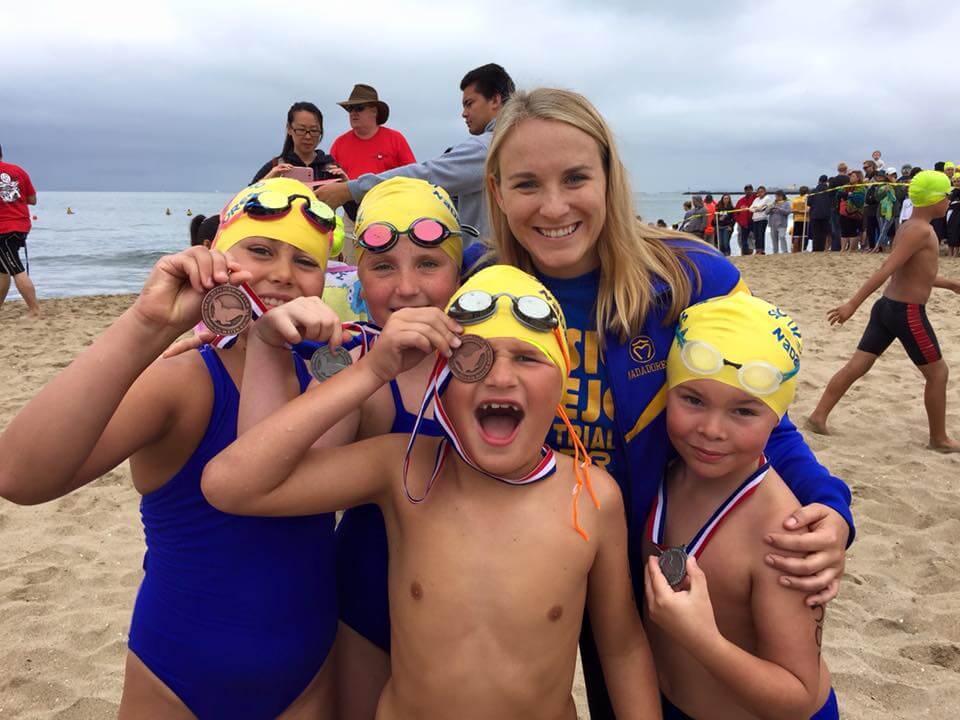
By Michaela Morrison, Swimming World College Intern.
Coaches – it’s that time of year again! Now that children are out of school, parents are getting them involved in all sorts of activities to stay busy. It’s your summer break too, and you’re ready to earn some coin from coaching and teaching private lessons.
Working with children also means working with their diverse personalities. Coaching requires us to recall our early swimming days: Which coaches did we like, and why were they so memorable?
Coaching provides an opportunity to teach a life-long skill and instill a love for the sport. So what are some ways we can hone our coaching craft and continually draw kids back to the water?
Reconnect with Your Inner Child
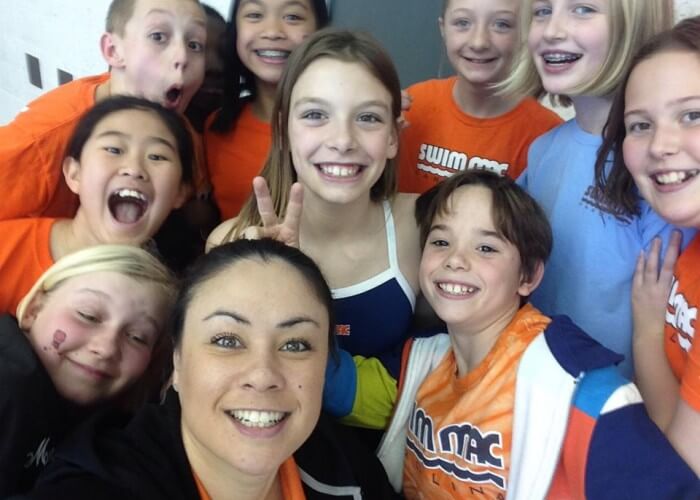
Photo Courtesy: Julia Czentye
Oftentimes, a kid’s interest in an activity is sparked by an incredible instructor. By being enthusiastic about your work, you can connect with children and understand how they operate.
Working by-the-book has been ingrained into our way of thinking and acting. We’ve been doing the daily grind (i.e. school and work) far too long and tend to forget what it was like to have the undying imagination of a child.
However, this coaching experience should be a way to allow your inner-child to play again. When children see how excited you are about being with them, they are more willing to listen and obey.
Be creative with your lesson or practice plans. Find different ways to present a new skill, and entertain the part of a child’s brain that is seeking play and new experiences. By doing this, you keep them engaged while also challenging them.
Kids don’t want to be bored: if putting fins on or doing mini-competitions helps exercise a skill in a fun way, go for it.
Use Repetition and Instant Feedback
Once children are engaged during their lesson, they’re more receptive to internalizing and retaining information. You want to talk with them instead of talk at them. Make sure you point out aspects of their swimming they can improve, but also give praise where praise is due.
Kids’s minds wander easily during practice, which challenges the coach to be on the lookout for illegal breaststroke kicks or one-handed open turns. Stopping swimmers at the wall to correct a mistake right away will help them stay on task and engaged.
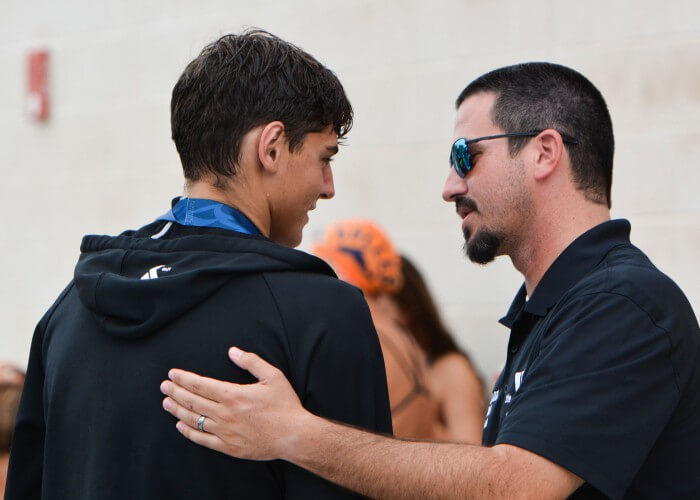
Photo Courtesy: Donna Nelson
One creative coach attached PVC pipes to the lane lines under the flags in order to teach his swimmers to push off in a tight streamline past the flags off each wall. Many swimmers bumped into the pipe, which greatly slowed their momentum if they didn’t kick out far enough.
Through this constant repetition and understanding of how imperfect streamlines slowed their momentum (and from the coach yelling if they tried to sneak around the PVC pipes), the athletes set themselves up for faster swimming. Immediate consequences for failing to perform proper technique, such as running into a PVC pipe, can quickly correct repetitive mistakes.
Remind Swimmers of their Goals
At the beginning of the lesson, go over small, memorable goals. Before a drill or set, ask the swimmers to identify mini goals. In freestyle, you can remind them to push off in streamline, to avoid breathing on their first stroke, and to rotate their bodies with each stroke. Have them verbally repeat those goals back to you to ensure comprehension.
Ask them how they feel while swimming: if their legs are dragging or if they notice they are pausing too long between each stroke in breaststroke. Encouraging body awareness in the water will help swimmers understand which body part is causing technique issues, while you can provide a solution.
Or, you can turn the tables by asking if they can think of a solution. Maybe they don’t know what you’re looking for; however, by guiding swimmers through the conversation, they will feel a sense of ownership when they’ve come up with a solution themselves.
Connect to Prior Knowledge
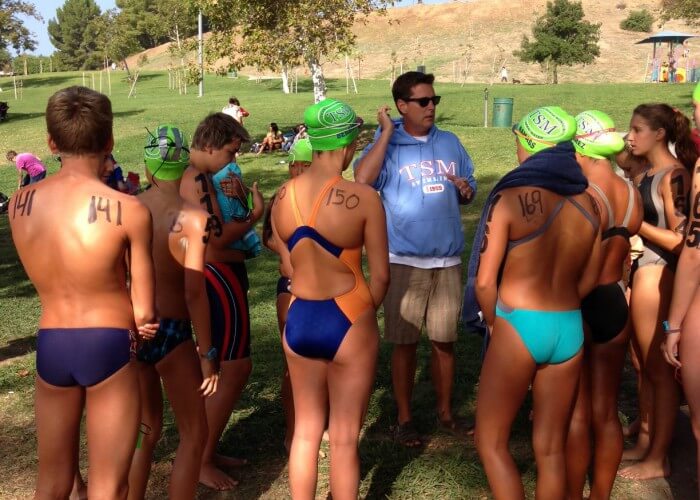
Photo Courtesy: Cathy Gomez
Learning new information is more worthwhile when it’s both fun and applicable. Children can easily visualize the action of blowing out candles on their birthday cake, which is helpful imagery when teaching how to blow bubbles underwater.
Children most likely won’t understand the boring biomechanical explanation for why they need to “keep their hips up” in backstroke. Instead, you should relate that motion to a common childhood experience or comical situation. You could have them imagine a plate of their favorite food on their chest. Since they can’t use their arms to eat because they’re pulling, the swimmers have to lean back to figuratively slide the plate to their mouth so they can eat it. You could also have the swimmer try to balance a rubber duckie or other water toy on their head and see how far they can swim without the animal falling off, or “drowning.”
Now that the kids have this visual, they understand what get your hips up means without confusion.
Communicate with the Parents
If the swimmers are struggling to grasp a concept, or their behavior is not appropriate for a team or one-on-one session, don’t be afraid to talk with the parents. No parent likes to be told that their child has flaws; however, approaching the conversation in a mature manner will help the child excel in aspects that extend beyond swimming.
Keep the parents in the loop with their child’s progress and how to help their child improve. Because most coaches were once swimmers themselves, they can easily translate swimming concepts into comprehensible language for parents. Take time to listen and see the parents’ perspective.
Many parents want their child to be the best from an early age and push too hard too soon. Reiterate that parents should be encouraging their child to focus on building skills rather than winning at all costs. Help swimmers employ the if-then analysis: If you put your head down on your last stroke into the wall, then you will drop time.
This gives the child an incentive, much like giving a lollipop after a doctor’s appointment. It is also a clear way for the swimmer to recognize which skill is required to become faster.
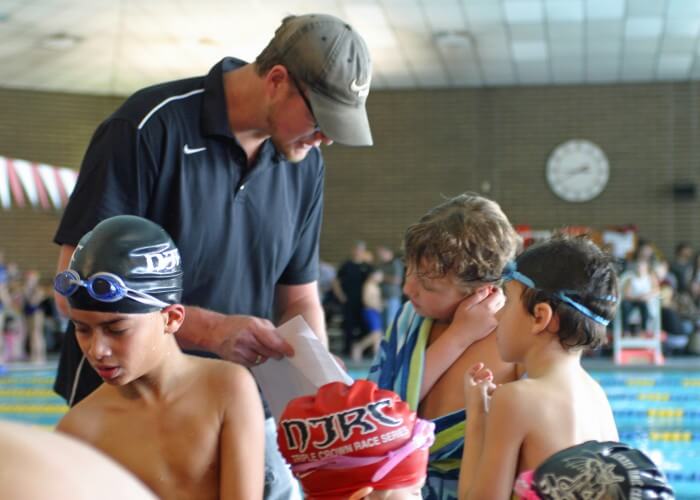
Photo Courtesy: Andreas Roestenberg
Prolong Success
The biggest challenge when coaching children is figuring out ways to keep the sport enjoyable. If the kids dream of a future with swimming, it’s crucial to find the balance between work and play. Not every practice can or will be fun, but showing them how far they can take their skills gives them something to work for.
It is okay to be frustrated when a swimmer is having difficulty understanding a concept that seems so easy to comprehend as a coach. But also understand that by showing your frustration, the child will feel incapable of ever completing the skill.
Coaching requires patience, and reiterating the fundamentals of the skill in question will eventually take root. Children typically say “Okay!” but don’t actually understand what you are saying. Talk it out with them and have another swimmer model the skill – or show them yourself! Kids grasp concepts better after watching a demonstration.
Coaches who show a genuine interest in their swimmers’ success are the ones who have the most rewarding experience. Many swimmers and “swammers” have learned valuable life lessons from coaches, and now, you have the incredible opportunity to help others along their journeys!
Commentary: All commentaries are the opinion of the author and do not necessarily reflect the views of Swimming World Magazine nor its staff.




And Masters ☺️
Gabi Gray – I see a familiar face!
He was so little…..❤️
Go MVN! I see several familiar faces! We miss you Coach Abbey!
I see Giselle and who is next to her?
Is that Nicole Christensen?
So many wonderful memories! Miss my MVN fam ?
Meg Lowrey
Vivianne Schaffer we both will need this